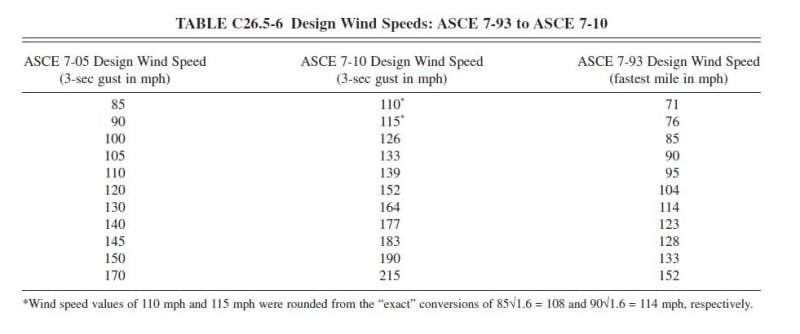I couldn't find any references to this online, and this is a huge oversight by the IBC committee. Any engineers working with wind, especially with older standards or software, or anything that references this very familiar equation, should be aware of the correct calculation, just incase it matters for your situation.
The incorrect equation:
V.asd = V.ult * sqrt(0.6), (IBC Section 1609.3.1 Wind peed conversion, (Equation 16-33))
The correct equation:
V.asd = V.ult * sqrt(1/1.6) = V.ult(2016) * sqrt(0.625)
This is trying to convert 1.0 Ultimate wind speeds to the 1.6 factored Allowable wind speed. This equation is easily derived from the calculation of wind pressure, which includes a V^2 factor. So, all other things being equal, converting 1.0 Ultimate wind speeds to Allowable wind speeds that requires a 1.6 factor (ASCE7-05, 2.3.2), requires dividing by a factor of 1.6^(1/2), which is equal to 0.625^(1/2), not 0.6^(1/2).
This may seem relatively minor, and it typically is, but many MANY pieces of software and other codes use this same wrong equation, creating UNCONSERVATIVE situations where the actual code-specified wind speed is greater than the equation provides.
The incorrect equation:
V.asd = V.ult * sqrt(0.6), (IBC Section 1609.3.1 Wind peed conversion, (Equation 16-33))
The correct equation:
V.asd = V.ult * sqrt(1/1.6) = V.ult(2016) * sqrt(0.625)
This is trying to convert 1.0 Ultimate wind speeds to the 1.6 factored Allowable wind speed. This equation is easily derived from the calculation of wind pressure, which includes a V^2 factor. So, all other things being equal, converting 1.0 Ultimate wind speeds to Allowable wind speeds that requires a 1.6 factor (ASCE7-05, 2.3.2), requires dividing by a factor of 1.6^(1/2), which is equal to 0.625^(1/2), not 0.6^(1/2).
This may seem relatively minor, and it typically is, but many MANY pieces of software and other codes use this same wrong equation, creating UNCONSERVATIVE situations where the actual code-specified wind speed is greater than the equation provides.


![[smile] [smile] [smile]](/data/assets/smilies/smile.gif) .
.